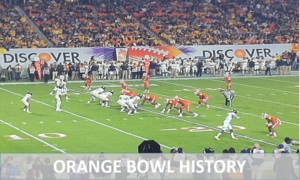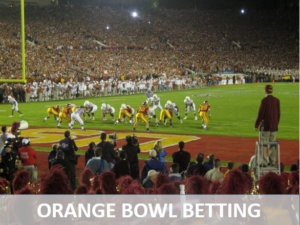Orange Bowl History

The Orange Bowl, along with the Sugar Bowl, was created in 1935 and is the second oldest bowl game. After the success of the oldest bowl game, the Rose Bowl, the city of Miami decided to host its own bowl game. That bowl game was the Palm Festival Game. George E. Hussey organized the game to try to help the city of Miami out of the Great Depression. The Palm Festival only lasted for two years, but it set the stage for the Orange Bowl.
This game, along with four others, is a BCS bowl game. As a BCS member, the Orange Bowl hosted the National Championship in 2001 and 2005. Oklahoma has owned this bowl throughout its history while having more appearances and wins that any other team in the game’s history.
The 2006 Orange Bowl was initially famous for pitting historic coaches Joe Paterno of Penn State against Bobby Bowden of Florida State at the end of their careers. Even though Penn St. technically won the game, the NCAA vacated that victory in response to the Jerry Sandusky sex abuse scandal.
Orange Bowl Qualification and Participation
The predecessor to the Orange Bowl, the Palm Festival Game, was not actually considered a bowl game. Since one team, the local Miami Hurricanes, were guaranteed a spot in the game, the NCAA failed to recognize the Palm Festival Game as a bowl.
The Orange Bowl did not give the Hurricanes an automatic bid, so it has always been a legitimate bowl game. From 1968 to 1998 the game featured the winner of the Big Eight Conference against another top tier opponent. After the conference acquired four more teams and became the Big 12, the conference’s bowl game tie-in moved to the Fiesta Bowl.
For the Next eight years the game hosted either the Big East or the ACC champion. Because of a continual decline in the quality of Big East teams, the conference lost its automatic bid to the Orange Bowl in 2005. Now the game will host the ACC champion along against an at-large team, unless the ACC champion is nominated to play in the National Championship Game.
Orange Bowl Location

The two games of the Palm Festival Game were played in Moore Park in Miami. The First official Orange Bowl games were played at Miami Field. Soon after these first few games the venue was moved to the Miami Orange Bowl. In 1996 the game was moved to its current site, Sun Life Stadium, located in Miami Gardens, Florida.
The Orange Bowl was played for a final time in the Miami Orange Bowl in 1999 because the hometown Dolphins had a playoff game on the same day. Like the four other BCS game sites, Sun Life Stadium hosts the BCS Championship game every four years.
Orange Bowl Betting
Because of the game’s popularity, wagering on the Orange Bowl is very common among college football fans. Since the ACC gets an automatic bid to the game, that conference usually must be considered before placing a bet. Recently the ACC has become a weaker conference in comparison with the other major football conferences.
However when betting on the spread one must decide if the conference champion is significantly better than the rest of the conference. The game is played in Miami Florida so teams that are significantly closer to the stadium may have an advantage over the opponent. Therefore conferences like the ACC and SEC may fair better in the Orange bowl than teams that have to travel farther.
